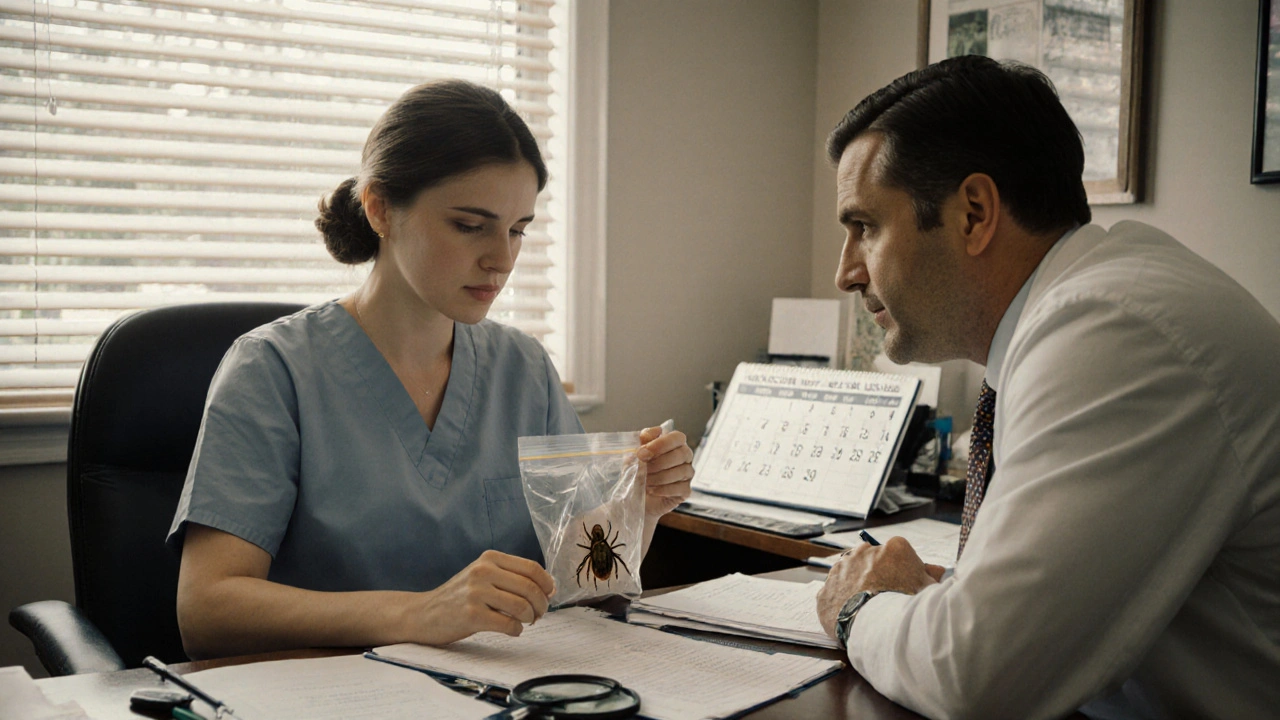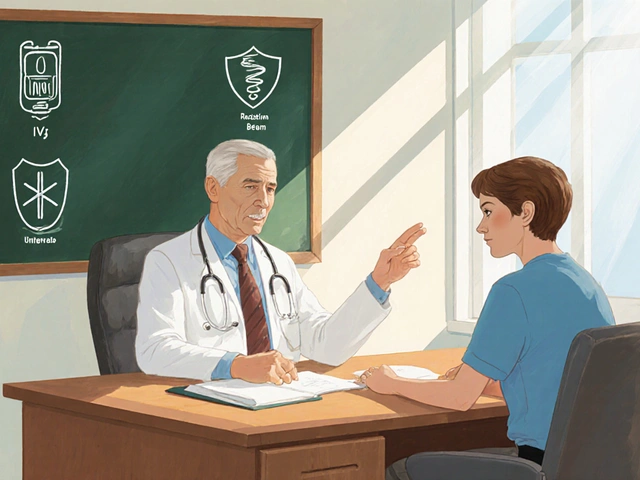Most people don’t realize that a tiny tick bite can lead to months - or even years - of fatigue, joint pain, and brain fog. Lyme disease isn’t just a summer camping hazard. It’s a complex, often misunderstood infection that slips under the radar because its symptoms look like the flu, arthritis, or even depression. And if you miss the early signs, the battle gets much harder.
How Lyme Disease Starts - And Why Timing Matters
Lyme disease begins with a bite from an infected blacklegged tick. In the U.S., two species carry the bacteria: Ixodes scapularis in the Northeast and Upper Midwest, and Ixodes pacificus on the West Coast. The real danger? Nymph ticks. These are the size of a poppy seed - nearly invisible. They’re most active in late spring and early summer, right when people are out hiking, gardening, or playing with kids in the grass.
Here’s the critical part: the tick must be attached for at least 24 hours to transmit the bacteria. Some studies suggest transmission can start as early as 15 hours, but the CDC says 24+ hours is the real threshold. That’s why checking yourself after being outdoors isn’t optional - it’s life-changing. A quick shower and full-body check within two hours can cut your infection risk by 95%.
Once the bacteria enter your body, they don’t sit still. They spread slowly, like ink in water. And that’s why the timeline of symptoms matters so much.
The Three Stages of Lyme Disease - And What Happens in Each
Lyme disease doesn’t hit all at once. It unfolds in stages, and each stage has different symptoms - and different treatments.
Stage 1: Early Localized (1-28 days after bite)
This is your best shot at stopping Lyme cold. About 70-80% of people develop a rash called erythema migrans. It starts as a red spot, then expands into a bull’s-eye pattern - a red ring with a clear center. It’s not itchy or painful, so many people ignore it. Some don’t even notice it. But if you see it, don’t wait for a lab test. That rash alone is enough for a diagnosis.
Alongside the rash, you might feel feverish, tired, or have headaches. These aren’t just “bad flu” symptoms - they’re your body fighting off Borrelia burgdorferi, the bacteria behind Lyme. If you catch it now, treatment is simple: 10-21 days of oral antibiotics like doxycycline (for adults) or amoxicillin (for kids). Most people feel normal again in a few weeks.
Stage 2: Early Disseminated (weeks to months after bite)
If you miss Stage 1, the bacteria start spreading. Now you’re looking at more serious problems. Multiple rashes can appear on other parts of your body. You might get facial paralysis - one side of your face droops. That’s called Bell’s palsy, and it’s a red flag for Lyme. Some people develop heart issues: irregular heartbeat, dizziness, or shortness of breath. That’s Lyme carditis. It’s rare, but it can be life-threatening if ignored.
This stage needs stronger treatment: 14-28 days of IV antibiotics like ceftriaxone. Oral antibiotics may still work, but IV gives you a better chance of clearing the infection before it settles in.
Stage 3: Late Disseminated (months to years after bite)
This is what happens when Lyme goes untreated for too long. About 60% of people develop severe joint pain and swelling - usually in the knees. The pain comes and goes. You might feel fine one week, then be unable to walk the next. Nerve damage can cause numbness, tingling, or shooting pains. Cognitive problems - brain fog, memory lapses, trouble concentrating - are common. Some people describe it as feeling like they’re stuck in slow motion.
At this point, treatment still helps, but recovery takes longer. Antibiotics can clear the infection, but the damage to nerves and joints may linger. That’s where things get complicated.

What Is Post-Treatment Lyme Disease Syndrome?
Even after finishing antibiotics, 10-20% of patients still feel awful. Fatigue. Muscle aches. Trouble thinking. This isn’t “chronic Lyme” - it’s Post-Treatment Lyme Disease Syndrome (PTLDS). The bacteria are gone, but your immune system is still on high alert. It’s like your body won’t turn off the alarm after the fire’s out.
Dr. John Aucott at Johns Hopkins has studied this for years. His research shows PTLDS isn’t caused by lingering infection. It’s an immune response. That’s why more antibiotics won’t help. In fact, long-term antibiotics can cause more harm than good - yeast infections, gut damage, antibiotic resistance.
But that doesn’t mean you’re out of options. Physical therapy, pacing your activity, sleep hygiene, and stress management can help your body reset. Some patients find relief with cognitive behavioral therapy. It’s not a magic fix, but it’s evidence-based.
Why Diagnosis Is So Hard - And How to Push for It
Here’s the ugly truth: 63% of Lyme patients see three or more doctors before getting diagnosed. Why? Because blood tests are unreliable in the first few weeks. Your body hasn’t made enough antibodies yet. A negative test doesn’t mean you’re clean.
Doctors rely on two-tiered testing: ELISA first, then Western blot. But in early Lyme, those tests miss up to 40% of cases. The CDC says if you have the bull’s-eye rash, you don’t need a test. But many doctors don’t know that. A 2022 study found only 52% of primary care doctors could correctly identify all three stages of Lyme.
If you’ve been bitten by a tick and feel sick, say this: “I think I might have Lyme disease. I had a tick bite and now I have these symptoms.” Don’t wait for a test. If you have the rash, ask for antibiotics immediately. If you don’t have the rash but have unexplained joint pain, fatigue, or neurological symptoms after a tick exposure, insist on being evaluated for Lyme.

What’s New in Lyme Disease - And What’s Coming
There’s hope on the horizon. In March 2023, the FDA approved the first new Lyme diagnostic test in 20 years: the MiQLick test. It detects bacterial DNA in urine with 92% accuracy - even in early infection. That’s a game-changer.
A new vaccine, VLA15, is in phase 3 trials. It targets multiple strains of Borrelia and showed 70-96% effectiveness in early studies. If approved, it could be available by 2027.
Researchers at NIAID are also working on an mRNA vaccine - similar to the ones used for COVID-19. Human trials are expected to start in 2024.
Meanwhile, climate change is making things worse. Ticks are moving north. In Canada, their habitat expanded by 50% between 2000 and 2020. More people are at risk. More cases are expected. By 2050, the CDC predicts Lyme cases could double.
What You Can Do Right Now
You can’t control the ticks, but you can control your response.
- Wear long pants and tuck them into socks when walking in tall grass or wooded areas.
- Use EPA-approved repellents with DEET or permethrin on clothing.
- Check yourself, your kids, and your pets every time you come inside.
- If you find a tick, remove it with fine-tipped tweezers. Grasp close to the skin and pull straight up. Don’t twist. Don’t squeeze.
- Save the tick in a sealed bag. If you get sick later, it can help doctors.
- If you live in a high-risk area and get bitten by a tick that’s been attached for more than 36 hours, ask your doctor about a single 200mg dose of doxycycline within 72 hours. It can prevent infection.
Lyme disease isn’t a death sentence. It’s a race against time. The sooner you act, the better your chances.
Can you get Lyme disease from a dog or cat?
No, you can’t catch Lyme disease directly from pets. But dogs and cats can bring infected ticks into your home. Check your pets after they’ve been outside, especially in wooded or grassy areas. Use tick preventatives recommended by your vet.
Is Lyme disease contagious between people?
No. Lyme disease is not spread through touch, kissing, sex, or blood transfusions. There’s no evidence it can be passed from mother to baby during pregnancy - though untreated Lyme during pregnancy can cause complications. Always treat Lyme promptly if you’re pregnant.
Do all ticks carry Lyme disease?
No. Only blacklegged ticks (Ixodes species) carry the bacteria that cause Lyme. Even among those, only a small percentage are infected - usually 10-30% depending on the region. But you can’t tell by looking. Always treat any tick bite seriously.
Can you get Lyme disease more than once?
Yes. Recovering from Lyme doesn’t give you immunity. You can be bitten again - and get infected again. That’s why ongoing prevention matters, even if you’ve had it before.
What should I do if my symptoms come back after treatment?
First, don’t assume it’s Lyme again. Other conditions - like rheumatoid arthritis, fibromyalgia, or vitamin deficiencies - can mimic Lyme symptoms. See your doctor. Get a full evaluation. If you had a confirmed case and your symptoms return, it could be PTLDS. Don’t push for more antibiotics unless there’s clear evidence of reinfection. Focus on rest, physical therapy, and managing stress.






Comments
Neoma Geoghegan
23/Nov/2025Tick checks after outdoor time saved my life. No rash? Still get tested. Don't wait. Just do it.
Bartholemy Tuite
23/Nov/2025Man I remember hiking in Killarney back in '19 and finding a tick stuck to my ankle like it was trying to move in. Didn't think twice till I got a headache and joint pain for three weeks. Docs thought it was stress. Turns out it was Lyme. Took a month of doxy and I still get weird brain fog sometimes. Bottom line? If you're in a tick zone and feel off after being outside, don't let some GP dismiss you. You know your body better than any lab report. And yeah the bullseye rash is the golden ticket but not everyone gets it. I didn't. So don't wait for the poster symptom. Just act.
Sam Jepsen
23/Nov/2025Just got back from a weekend camping trip in Ontario. Did the full tick check on me, my dog, and my partner. Tucked pants into socks, DEET on skin, permethrin on clothes. It's not paranoia, it's prevention. Lyme is real, it's rising, and we can beat it with simple habits. Share this with your friends who think ticks are just a summer nuisance. This isn't optional.
Yvonne Franklin
23/Nov/2025Stage 3 Lyme is brutal. I had knee swelling that came and went for 18 months. No one believed me until I got an MRI showing synovitis. IV antibiotics helped but the nerve damage stuck. PTLDS isn't in your head. It's your immune system stuck in overdrive. Physical therapy and sleep hygiene made more difference than any antibiotic ever did. Don't let anyone tell you it's all psychological.
New Yorkers
23/Nov/2025They want you to believe antibiotics fix everything. But what if the real problem isn't the bacteria? What if it's the modern world's collapse of immune resilience? We've sterilized ourselves into vulnerability. Ticks are just the messenger. The real disease is our disconnect from nature, from rhythm, from truth. You think doxycycline heals? It just masks the symptom of a deeper rot.
manish chaturvedi
23/Nov/2025In India, we don't have blacklegged ticks but I've seen many travelers return from North America with unexplained fatigue. This post is vital. The science is clear. Early detection saves lives. Prevention is not just personal responsibility-it's public health. We must spread awareness globally. Even where ticks don't live, returning travelers carry the burden. Education is the real vaccine.
Nikhil Chaurasia
23/Nov/2025I respect the info here but I have to say-I’ve seen too many people panic over a tick bite. Not every bite means Lyme. Not every fatigue is Lyme. I don’t want people to live in fear. But I also don’t want them to ignore real danger. Balance. Awareness. Not alarmism. And please, don’t self-diagnose. See a doctor who knows the difference between Lyme and fibro.
Holly Schumacher
23/Nov/2025So let me get this straight-you're telling me we should just give antibiotics to everyone who gets a tick bite? No testing? No confirmation? That's how you create superbugs. And now you're promoting unproven 'mRNA vaccines' like they're magic? This isn't medicine, it's fearmongering dressed as education. The FDA doesn't approve tests overnight. And you're acting like the MiQLick test is a miracle when it's still in early validation. Wake up.
Michael Fitzpatrick
23/Nov/2025My sister had Lyme back in '17. She got the rash but her doctor said it was just a bug. Three months later she couldn't walk. She ended up in the ER with heart palpitations. Got IV antibiotics. Took a year to feel normal again. Now she's an advocate. She checks her kids every single time they come in from the yard. And she tells everyone: if you're in the Northeast, Midwest, or anywhere with deer ticks, you owe it to yourself to know this stuff. It's not about being paranoid-it's about being prepared. I'm so glad someone finally put this out there clearly.
Shawn Daughhetee
23/Nov/2025Just found a tick on my dog after the hike. Took it off with tweezers saved it in a bag like the post said. My wife says I'm overreacting but I'd rather be safe. I got the doxy shot last year after a bite and it worked. No rash no symptoms. Just being smart. If you live where ticks are common this stuff matters. Don't wait till you're in pain.
Miruna Alexandru
23/Nov/2025Let’s be honest: the entire Lyme narrative is weaponized. The CDC’s two-tier testing is outdated, yes, but replacing it with urine DNA tests? That’s not science, it’s commercial desperation. And the vaccine hype? It’s the same pattern as every other pharmaceutical miracle-overpromised, underproven, and overpriced. Meanwhile, PTLDS is dismissed as psychosomatic, but the real issue is that the medical system refuses to acknowledge chronic immune dysregulation because it can’t be monetized. This isn’t a public health crisis-it’s a systemic failure masked as education.
Julie Pulvino
23/Nov/2025My mom had Lyme in the 90s and they misdiagnosed her for years. She ended up with chronic pain and depression. Now she’s healthy because she found a doctor who listened. This post saved me from making the same mistake. I just got back from a trail run and did my tick check. I’m so glad I read this. Thank you for the clarity. I’m sharing it with my whole family.
David Cunningham
23/Nov/2025Australia’s got its own tick problems-Paralysis ticks are nasty. But I’ve seen Americans panic over deer ticks like they’re zombies. Look, ticks are everywhere. You don’t need to live in fear. Just be smart. Check yourself. Use repellent. Know the signs. That’s it. This post nails the practical stuff. No drama. Just facts. Love it.
luke young
23/Nov/2025My buddy had Lyme and they gave him antibiotics for 30 days. He felt better but then the fatigue came back. He’s been doing yoga, acupuncture, and walking every day. No more meds. Just slow healing. He says his body finally caught up. I think this post is right-antibiotics don’t fix everything. Sometimes you just need time and peace. Thanks for sharing the real story.